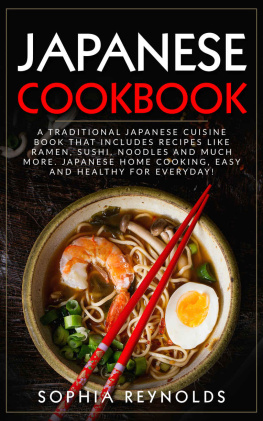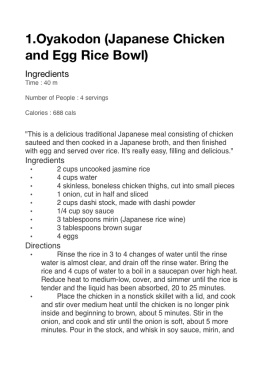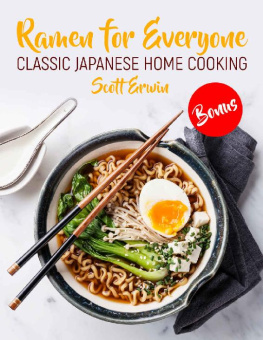A traditional Japanese cuisine book that includes recipes like ramen, sushi, noodles and much more. Japanese home cooking, easy and healthy for everyday!
INTRODUCTION
Japanese food culture is booming. In big cities and in the countryside, restaurants offer great local products and special items. In Japan, delicious food is not just a big business and a national pastime. It is an inalienable right.
This cookbook will help give you a quick peek on how to cook and efficiently enjoy your choice of Japanese cuisine at home. Whether you are professional chef or an amateur, it doesnt really matter, just follow these steps and you are on your way to enjoying a sweet savory Japanese meal.
Japanese people call every meal "gohan." For example, breakfast is known as "asa-gohan." A bowl of steamed rice is considered great for ordinary Japanese suppers and may be a part of breakfast, lunch, or supper. Side dishes are alluded to as okazu and are presented with rice and soup. Rice is a staple of the Japanese eating regimen. Rice sweets (mochi) are additionally for the most part eaten up. They vary from sweet to exquisite and highlight numerous selective plans from boiled to flame broiled.
Customary Japanese breakfast incorporates steamed rice, miso (soybean glue) soup, and other dishes, comprising of flame broiled fish, tamagoyaki (moved omelet), pickles, nori (dried kelp), natto, etc. Different rice bowls and noodle dishes are famous for lunch. For instance, ramen, soba, udon, and gyudon pork bowls are renowned. Numerous individuals take bento lunch boxes to class or work. Supper is commonly the essential dinner of the day and might extend from sushi to tori katsu, which resembles a chicken cutlet. Current Japanese dishes are phenomenally influenced with the guide of various Asian and Western cooking styles.
Seafood
Other than rice, fish is particularly benefited from in Japan since Japan is surrounded by means of seas. Ocean plants, fish, shellfishes, and fish treats are famous components in Japanese cooking. Obviously, sushi and sashimi are likewise very well known.
Dashi Soup Stock
Dashi soup inventory used in conventional dishes is crafted from katsuobushi (dried bonito flakes) and/or kombu (kelp). The inventory is used as a base for noodle, seafood, or other dishes.
Seasonings
The following seasonings are very vital for cooking Japanese meals: mirin, soy sauce, and miso and Umani
Wa-Shoku
Japanese human beings distinguish traditional Japanese-fashion dishes as "wa-shoku" (wa-shoku means Japanese-fashion, and shoku means meals) in preference to Western meals, which is generally known as "yo-shoku."
Regional Differences
Every region or city in Japan has its very own specials. Mainly, there are the Kanto regional meals (eastern place on the main island) and Kansai regional meals (western location on the primary island). Generally, Kanto food has robust flavors, and Kansai meals are gently seasoned. Many dishes are cooked in a different way among the Kansai and Kanto regions.
Cutlery and Table Settings
To devour Japanese-fashion meals, chopsticks are usually used. Japanese people use spoons, forks and knives as well to eat different kinds of meals, that arent bowl or pasta meals. The traditional Japanese table placement is to put a bowl of rice on your left and to put a bowl of miso soup on your right side on the table. Other dishes are set at the back of those bowls. Sushi may be the most frequently traveled word in Japanese. All over the world, Japanese cuisine is appreciated, and respected most of all.
Japanese cuisine includes a wide range of products, about 1,500 different items, with rice at the center. It also emphasizes seasonal products, and uses many fermented foods such as soy sauce, miso, and natto. These products are shared with other Asian countries, but also have their own Japanese style and taste. Japanese cuisine is unique in this one primary flavor, umami, which has attracted the attention of great chefs around the world.
Japanese eating rituals and customs are part of this unique heritage. Extensive detail to tableware and utensils, hospitality and ethics, are a common meal secret. Food visualization is an art form with great attention paid to even the tiniest delicacies. The Japanese meal is much more than just eating; it's socializing and communicating..
Japanese food culture has also resisted the spread of unwanted junk food and fast food, and remained largely healthy and energetic. Japanese cuisine contributes to the physical well-being, symbolic cohesion and daily enjoyment of the country. Adding Japan's unique food culture to UNESCO's list is an excellent way to express our justified pride in the country's cultural origins.
Breakfast in Japan is not the same as its Western counterpart. You will not find eggs, bacon, orange juice, or grains packed in any local food unless you are ordering from a Western food chain. Breakfast is like lunch or light dinner. It is a large meal that contains nutritionally well-balanced ingredients with no over-filling.
You will be introduced to these foods:
Miso soup
Steamed rice
Protein, usually grilled fish or fermented beans
Pickles
Seaweed
Light vegetables
Green tea
Comfortable dining options are available anywhere in urban areas, from the streets to the metro market. Don't be afraid to try these things when traveling, whether you are on a budget or not. Their fast foods are often prepared and served exquisitely in an open box with lots of variety and flavors. Their food comes with some of the most stringent safety standards anywhere, you are not likely to develop a disease that is transmitted by food there. This is true for both fresh preparations and seafood. Yes, try to indulge in all the beauty and flavors.
You can save a lot of time by having lunch on the go with a prepared lunch box instead of sitting in a restaurant, especially in Tokyo and other major cities like Osaka. Since most of the people here are busy, the most common lunch is a fast meal like:
Rice bowl with protein and vegetables (donburi). Don tempura is another very delicious option of rice bowl.
Noodle soup, such as ramen or udon
Bento boxes with some sushi and vegetables, and a small protein
Japanese Dinning Etiquette
Eating out in Japan comes with a few rules and ethics that you should be attentive to. It is inappropriate to put chopsticks inside the bowl or when not using it. Whether you eat traditional Japanese cuisine or eat in a contemporary restaurant, you will get a small ceramic or wood stand for chopsticks.
A typical Japanese dinner includes:
Steamed rice
Fresh vegetables or salad
Protein, often comprised of raw fish in the form of sushi, sashimi or beef Kobe
Pickled vegetables
Spices, such as soy sauce, sesame dipping sauce, and Japanese mayonnaise
Most of the main meals will include sweet, sour and sweet ingredients. The pickle ingredient aims to beat all of these notes and aid in digestion. If you are not the animal meat type, you will be able to enjoy tofu or fermented beans with your meal.
Drink Choices
Green teas often come along with the foods. But you can also get yourself a cup of coffee if that is what you prefer. The Japanese people love alcohol. Western whiskey is popular, and beer is the traditional soul of Japan. Sake, the wine made from fermented rice is a traditional alcoholic drink here. It is common to be in your best interest as it flows into a dish under the cup. This is a sign of appreciation. It is also acceptable for your companion to refill the cup for you.
Confections are Art
Wagashi are Japanese sweets that are simply great in their presentation. While sweets are something to look forward to at the end of the meal, Wagashi has received tremendous respect as it's own unique sweet.. These beautiful desserts are often served with tea. These dishes are made from a variety of interesting flavors. You may find green tea, red bean paste, mochi rice, sesame and ginger, to name a few.





